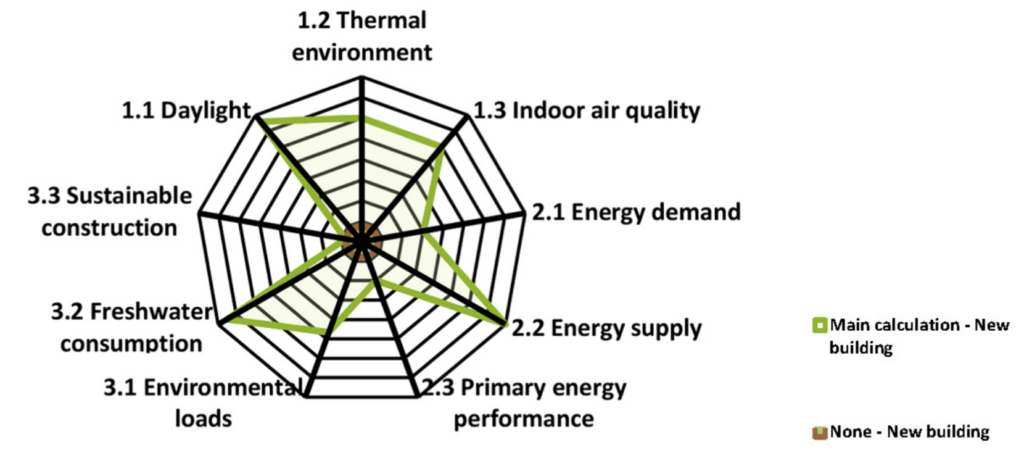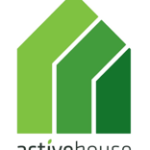014 Wetland Museum of GuanTing
Address of the project: GuanTing Wetland Park, Zhang JiaKou, China
Owner/investor –
Architect: Forestry Bureau of Huailai-Ren Jun, Jiang Nan
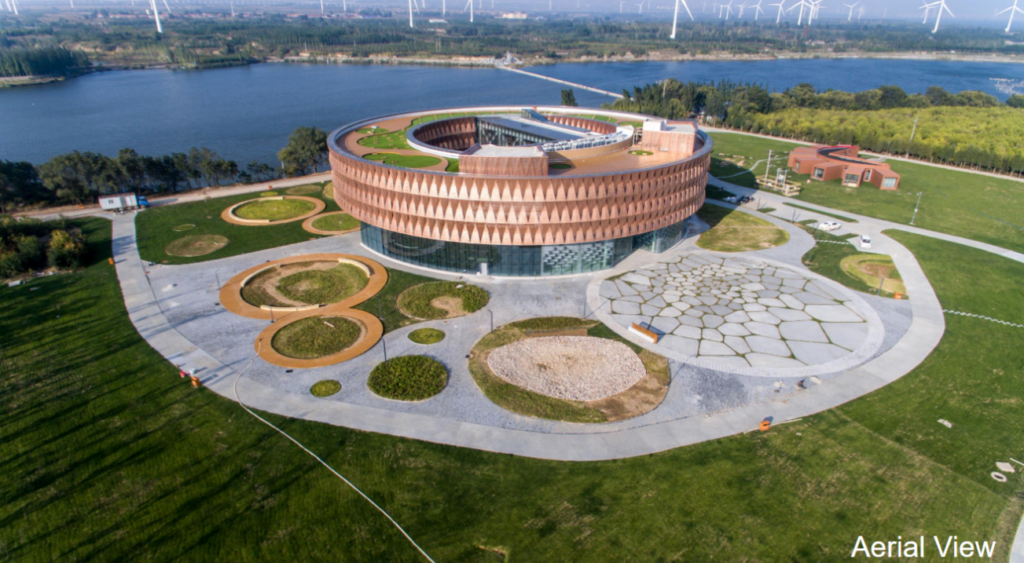
This wetland museum is located in the largestwetland near Beijing, which is the home for 40species of resident birds and a pathway of 151species of migratory birds. The overall goal of the project is to achieve a building that minimizes disturbance to the wetland and integrated into the nature, and includes three main goals respectively micro impact, zero emission and full cycling.
In this building, high-quality natural daylighting is provided for public spaces and exhibition halls —curtain wall and skylight are used for public area and the wetland landscape area to ensure good landscape view as well as natural daylighting. The average daylighting factor of the building reaches7.7%. The indoor operating temperature of the building is 26℃ in summer and 20℃ in winter, and the humidity in summer is lower than 60%. Natural ventilation is enhanced by means of the annular yard and elevated bottom, and fresh air is introduced from the wetland park by means of a fresh air system as well as the natural ventilation, so that the indoor CO2 concentration is lower than 700ppm.
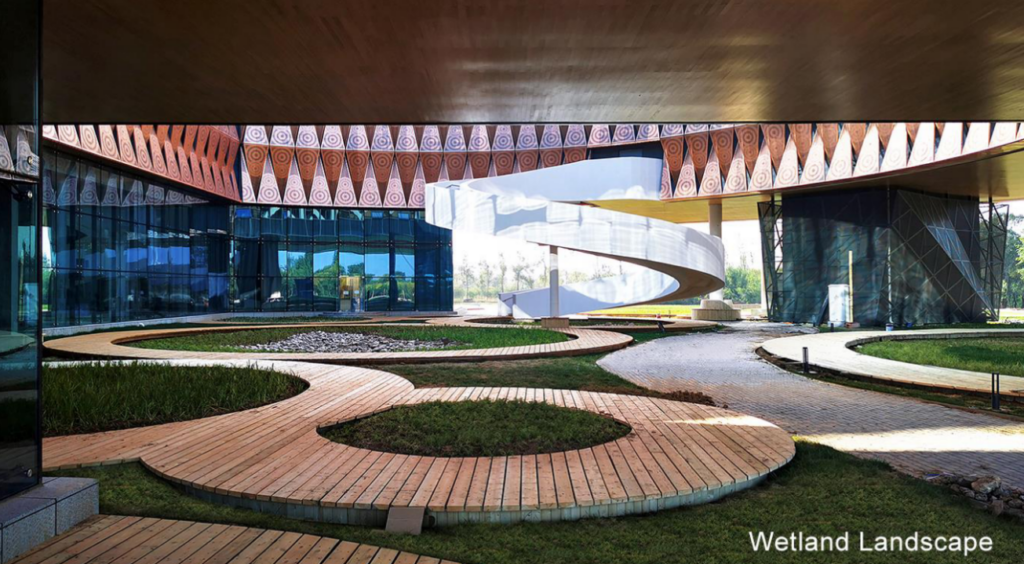
In terms of energy saving, considering the features of cold area where the museum is located, ring form that has a low shape coefficients chosen, and high-insulation enclosure systemand curtain wall system (exterior wallK=0.29w/m2.k and exterior windowK=1.80w/m2.k) are used to minimize energy use.
It utilizes solar energy and air energy to realize energy cycling. As electricity is the only energy source in the wetland park, a suitable VRV system is used for heat and cold supply, and LED lamps are used for lighting. In terms of solar energy utilization, colored film PV corridor and roof solar water heating system are set, with a renewable energy utilization rate of 6.1%.
There is a large amount of wind power generation in the Wetland Park, and the installed capacity of wind power generation equipment in the wetland park and surrounding mountains is about 150MW. The energy and power demand of the WetlandMuseum from the State Grid can be met by wind power generation.
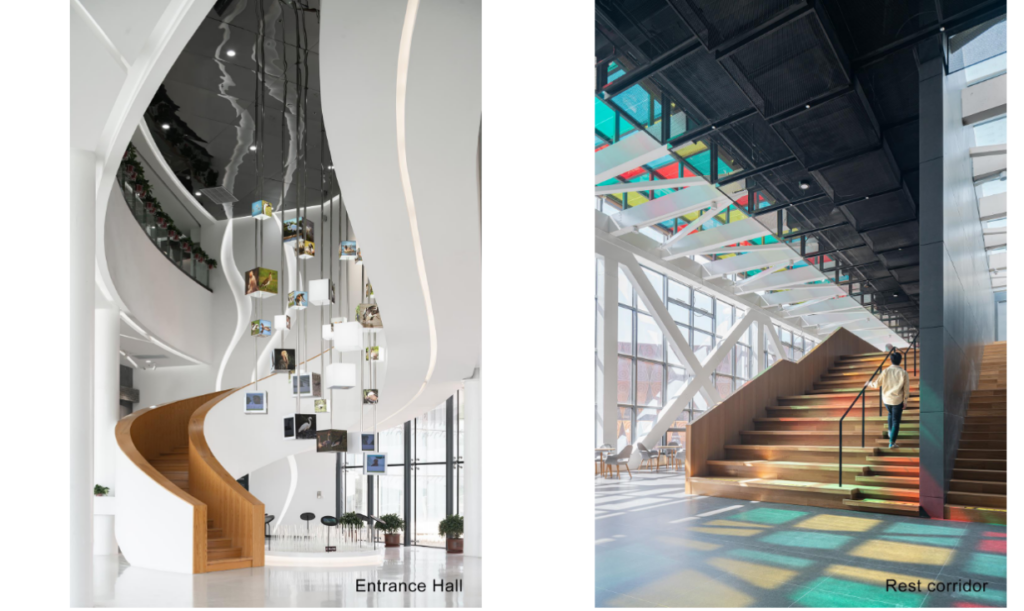
The overall goal of the project is to achieve abuilding that minimizes disturbance to the wetland and integrated into nature, and includes three main goals respectively microimpact, zero-emission and full cycling. The way to achieve the goal is to firstly use the annular floating strategy that elevates the building over the wetland, and then utilize low-energy building design, self cycling equipment and assembled construction.
Considering the landscape environment of the wetland park, the building is arranged on the site in the form of a floating ring. The space and form take into account the common attention to people and creatures. The courtyard connected with the nature and the elevated space allow birds, small animals and people to enter the semi-enclosed site in 24 hours, achieving symbiosis of the building and the environment.
There is no wetland ecological system in the park. The museum has built a sewage treatment system underground. After sewage treatment, it is naturally filtered and purified in combination with the sponge landscape. Finally, it reaches the standard of landscape water discharge and realizes zero discharge of sewage to the wetland ecosystem. Rainwater is recycled through collection and reclaimed water treatment. Realizerainwater circulation with the help of low impact development (LID) such as rainwater garden and constructed wetland, leading to a water conservation rate of 10%.
From the perspective of carbon sink, the building reduces land occupation as much as possible. The elevated building returns the natural space to the wetland. The enclosed outdoor courtyard is connected with the natural site through the elevated layer. The outdoor environment keeps the natural ecology of the wetland as well as the tall pagoda trees and Chinese pine forests around the building.
The vulnerability of the environment in wetlands requires minimization of the output of buildings to nature. The building uses the prefabricated steel structure, and realizes material cycling whole life cycle, from factory manufacturing to on-site installation and removal.
An antibacterial copper plate is selected for the building skin, and this material will be gradually oxidized from golden yellow to copper green and integrated with the environment. The gap between the skin and the building and the exterior suspended ceiling will become the birds nests. Based on research results, the pattern of glass curtain wall is designed with 100x50mmgrids that is sensitive to bird vision to prevent birds from hitting by mistake.
The vulnerability of the environment in wetlands requires minimization of the output of buildings to nature. Starting from design, the museum realizes full cycling of materials, energy and water system. The building uses the prefabricated assembled steel structure, and realizes material
cycling in whole life cycle, from factory manufacturing to on-site installation and removal. It utilizes solar energy and air energy to realize energy cycling.
RADAR
